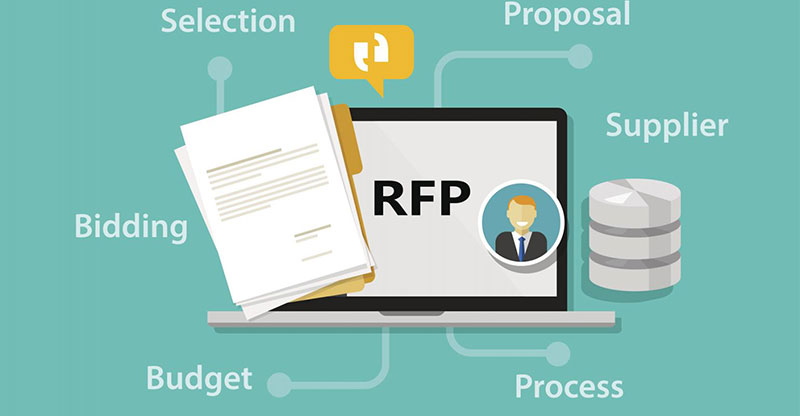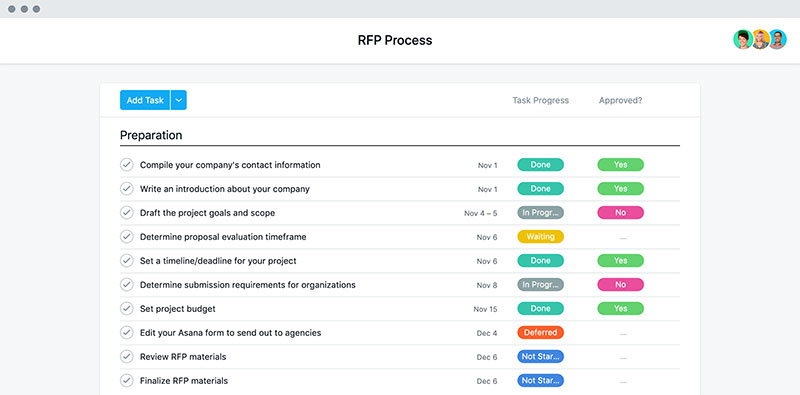How To Write An RFP: Guide On Software Development Request For A Proposal

Requests for proposal (RFPs) are a recurring requirement. Businesses involved in the service and consulting branches use them routinely. RFPs are the way to get new orders or contracts. Because they are remunerative, it is essential to know how to write a good one.
Also, writing superior requests results in avoiding problems further down the development road. These problems could include delayed software release dates, exceeding budgets, or other complicated issues. Making one good RPF template can make life much easier in the present and reduce stress in the future.
Writing a request for proposal is not an easy task for most business owners. Whichever format you use, whether it is for a mobile app, a website, a desktop application, middleware, or a small website redesign, the problems are similar. To help with designing a proposal, this article created by our team at TMS highlights the structure, expert advice, and practical tips on how to write an RFP for outsourcing a tech project.
What is an RFP?
Before diving into our subject of how to write an RFP, let’s discuss what it is.
Before choosing a development firm, the requesting company will write a request for development. This applies to software applications, but it could be anything. An RFP outlines the details of the project, requirements, deliverables, and timelines. Companies that offer the desired product or service then prepare quotes based on the request.
With the different bids in hand, the requesting company will choose a company by approving the bid. Besides that, they can see whether it is best to go for a Time & Material or a fixed price billing option.
What is the main objective of an RFP? It is to be able to compare bids and strategies to get as much information as possible. It can also reveal weak points in the request or details that before went unnoticed.
An RFP presents the company to potential partners, so composing them correctly is important. A well-crafted request will return quality proposals, smooth-running projects, and ultimately better results.
Who would write an RFP?
You could have several choices for the right person to write the request. It depends on the size of the project and the makeup of the team. For instance, it could be a project manager with the help of some subject-specific experts. Most of the time, the same people are later involved in evaluating the bids and the project itself.
In the case of software development, preparing an RFP is the result of teamwork. The main writer can be a business analyst, a product or project manager, or the product owner,. They will need input from team members that have an understanding of the technical aspects of the project. Of course, the exact way in which an RFP is detailed differs with each company.
Things work best when those who play a major role in the project are involved in preparing the request. Most software developers work according to the AGILE methodology, so it is practical to consider this in the RFP too.
We can help you turn your idea into reality, take over your existing project, or extend your current development team.
Schedule a free consultation at hello@tms-outsource.com, or fill out the form and we will follow up with you shortly.
What should be in an RFP?
Although there are no strict rules about what to put in an RFP, there are some common elements. It is important that the right amount of information is given, not too much and not too little.
With too little information it becomes difficult to make an informed decision on whether a vendor is qualified and able to do the job. Too many details and demands can scare potential vendors off from taking on the project. In deciding how much information to provide, it is necessary to examine the specific needs to make the right decision.
1. The Executive Summary and Company Description
The executive summary is a brief overview of the project’s goals, requirements, limitations, and target service providers. This summary should be concise and specific. Adding background information about the requesting company is helpful. In this way, the readers are better able to get an idea of the needs of the organization.
The company description mentions what it does, what its values are, what is special about the company, and about the product. Perhaps, the reader has never heard of the company or what it does and the website may not give those details.
Some requests for proposal contain the standard question: Present yourself as a company and why you fit this project? This is a rather vague question and will not likely return a helpful answer. Therefore, questions about the vendor’s background and qualifications must be more specific. The following are some questions that require a specific answer that help in selecting the best option.
- How long have you been in business?
- How is your company organized?
- What industries do you engage in?
- What is your client retention rate? How many projects do you have per client?
- What is your current headcount? What was your headcount last year?
- How many projects have you completed in the last three years?
2. Project Goals
When describing the project goals there are some things to keep clear in mind:
The goals should not be described in general terms. For example, the purpose of creating a website is not just to sell a product, or to interact with customers. It should rather be described in such terms as to promote omnichannel interaction with customers, or reduce cost and increase turnover.
Whenever quantitative goals should be set, they should be either final company goals or express the desired direction.
3. Budget
It is recommended to include a budget in the RFP. If a vendor knows how much a company is willing or able to spend on the project it is much more likely that they will go ahead and propose their offer.
Including a budget will give both sides security during further negotiations. The requesting company knows what they can offer and may be able to adjust timeframes. Likewise, the vendor can determine whether it is possible to complete the project within the proposed time and budget. It is better to not accept a project than fail to meet a deadline or run over budget.
4. Technical Requirements
Before starting the project, the technical requirements are not always clear. Nonetheless, in this section, the technical details must be described as clearly as possible.
A website is limited in the terms of any technical software. Deliverables are therefore described in those words. Here some common technical requirements:
- Ecommerce: Is the application for selling products, or only for charging debit cards? A web retail business requires a shopping cart, inventory control, and shipping calculators. A nonprofit organization only wants (recurring) donations.
- Content Management System: Is the project limited to a specific provider, like WordPress or Drupal? Or is the choice open?
- Backend Programming Language: Is there a limitation regarding the specific language? Or is it compatible with, for example, PHP, Python, or Ruby?
- Third-Party Software Integrations: Does the requesting company use third party companies? These are often used for accounting, email newsletters, CRM, intranet, inventory, and marketing.
- User Accounts: Is the site freely accessible, or are certain parts reserved for members with a password? This could be for members that have submitted their password, or after paying a certain fee.
- Mobile Responsive Design: Mobile responsiveness is a common requirement, but it is still advisable to include it.
5. Response Timeline
A timeline is not always defined in detail. In some cases, there are clear deadlines, such as the launch of a new product, an advertisement campaign, or a special event. It is necessary to specify any calendarial requirements for the prospective vendors.
Another point that falls under this section is whether the team members must work on the project full-time, or is part-time acceptable? Can the vendor make use of freelancers and sub-contractors? What is the deadline for vendors for submitting their proposals? Also, details about semi-finalists, interview procedures, and final selections should be provided.
It is good to ask what specific details are important for the project. It could be the names, titles, and experience of the people involved. Often, the teams are very well defined for small companies. In the case of larger teams, the individuals likely change according to the vendor’s needs.
6. Benefits
This section summarizes how the project will increase business value. This can be done in any format, such as organized in bullet points.
Return on Investment (ROI) is difficult to measure. Before the implementation of a tool, it is not exactly known how it will help a business to change and grow. During its lifetime new modules may have to be added or modified.
Although ROI is not known in detail from the start, most business leaders demand transparency when it comes to the benefits to the company. So the estimates should be founded on best projections and educated estimates.
In a worst-case scenario, the investment may not be fully returned. Still, in the benefits section transparency and realism should be packed in positive words.
7. Possible Constraints

Possible constraints include limited resources or custom factors. It helps vendors to decide if they are willing and able to take on the project. It is an effective way of determining offers that are not able to successfully finish the project. On the other hand, the ones that are qualified will come to the fore.
During software development as many problems as possible need to be avoided or at least anticipated. It could become apparent that infrastructure needs updating. Or that more personnel or different skill sets are needed. Analyzing these shortcomings will help to get an idea of what is required from a vendor.
Any roadblock should be listed under this section, both realized and the potential ones. Included can be equipment or plant limitations. Some plants close down at least once a year for maintenance.
Do not ignore constraints or obstacles, but do not make them bigger than necessary. Mention them honestly and provide solutions and alternatives.
8. Letter of Interest
Especially in software development, intellectual property is very important. The idea behind an application that does not have market precedence can be worth millions. Usually, it is up to a company to make its RFP public or not.
A letter of interest can cover many of the questions involving confidentiality. It can for instance specify with whom the information can be shared, require an answer, and limit risks.
Therefore, letters of interest are very commonly employed. In the first place, it includes a business introduction, project description, and deadlines. It mainly serves to establish contact with potential vendors. Then a preselection is made. More sensitive details about the software can then be shared with a selected group of service providers.
Reviewing Process
A final choice is made by reviewing the responses to the RFPs and additional questions and interviews of the selected candidates. Before reviewing all the information it is beneficial to establish a scoring system. Analyzing the answers in this way can reveal patterns and details even in similar bids.
One scoring method is based on assigning a score (for example 1-10) to each point and question in the RFP. Depending on how much an answer aligns with the needs of the company a score is awarded. The bids with the highest number of points are then selected.
Tips
The tips can help to understand what are the best practices and to be more effective in composing an RFP for software development purposes.
Be to the Point
The point of an RFP is to find the development solution that suits all the needs. If the request is not clear or does not come to the point, the potential partners have no way of knowing whether they can provide what is needed.
Deployment Method
There are different ways to host software. It can be installed on the company’s servers, or it can be hosted externally, on a cloud. It is important to know what is needed and express that need in the RFP.
Collaborate

Finding a solution requires you to know and understand the problem. So, before requesting help by issuing an RFP, familiarization with the issue is important. That involves talking and working with the people that are closely involved with the issue.
IT Infrastructure and Technical Requirements
IT experts are of much value in understanding and getting to know the problems and details.
Library of Standard Questions, Sections, and Templates
Every problem requires a unique solution. That means that every request for proposal will be slightly different. Still, some questions and sections will be similar or the same. Technical details will likely differ. But details about evaluation, customer success, and terms and conditions will probably be indistinguishable.
Needs and Wants
What is essential for the minimal viable product (MVP)? Are there things that would be nice but are not indispensable to finish the project successfully?
Multi-Step Processes
Most of the time, RFPs serve a very specific purpose. Although fulfilling all needs at once sounds appealing, it is usually not realistic or even practical. A multi-step solution may be much more desirable.
Inviting Too Many Vendors
This sounds tempting, but receiving too many bids at a time can become overwhelming. With some forethought, a preselection of potential partners can be made.
Transparency
Strive to be as clear and open as possible. Unclear RFPs only lead to frustrated vendors, or even confusion and difficulties once the project is started.
Visuals
The clearer an RFP, the more useful the responses will be. To show how the final product is envisioned add mock-ups and screenshots whenever possible. It will give the vendor a much clearer idea of what is being asked of them.
Patience
It takes a vendor time to come up with their bid. For bigger projects, this can take several weeks. So, if there is a deadline involved, make sure not to send the RFP at the last moment. Allow a vendor time to thoroughly go over the request and prepare a realistic offer. The determinations made at this point, create the course and outcome of the project.
Ending thoughts on how to write an RFP
Requests for proposals play a very important role in software projects and it is important to know how to write an RFP. There are so many things that can be included in a request that it can get complicated. The objective of this article is to provide help and information about how to write an effective RFP.
The most essential elements were discussed. It might not include every possible scenario, but any vendor would be happy to review an RFP that includes these sections. It will show a serious and thorough project. A clearly written request will show the vendor exactly what you are looking for and that you are determined to make it a success.
It may seem daunting, but a good software development RFP is not hard to compose. All of this becomes much easier if the reason for writing the request is clear.
It needs a purpose that can be used to the company’s advantage. Involve the team and include their input. The potential partner can then show how they can contribute to reaching the goal.
Looking for a development partner?
If you’re looking for a technology partner, development team augmentation, or just a company for your software&app development initiatives, consider TMS.
TMS is a software and digital company in Belgrade, Serbia. We develop innovative and modern software.
A few examples include premium booking software Trafft, MedTech apps like MR Prepare, or MarTech/AdTech apps like the Advise Media Suite, among other great software examples.
Check out our services and also some of the work we’ve done for our clients. Who knows, maybe we’ll form a successful relationship.
Schedule a free consultation at hello@tms-outsource.com, or fill out the form and we will follow up with you shortly.
If you enjoyed reading this article on how to write an RFP, you should check out this one about software development budget.
We also wrote about a few related subjects like how to hire a web developer, ALM tools, hire a web development team, application lifecycle management and web development companies in Serbia.



